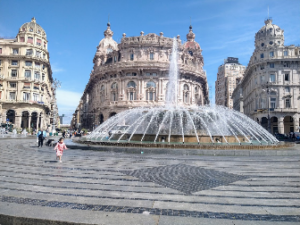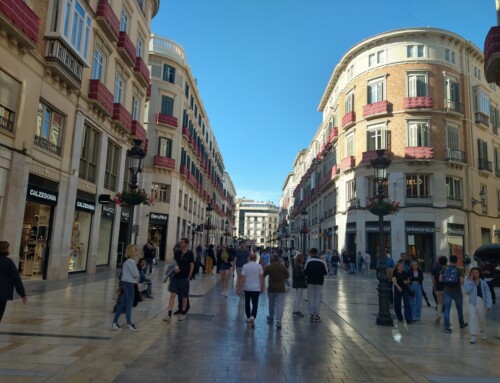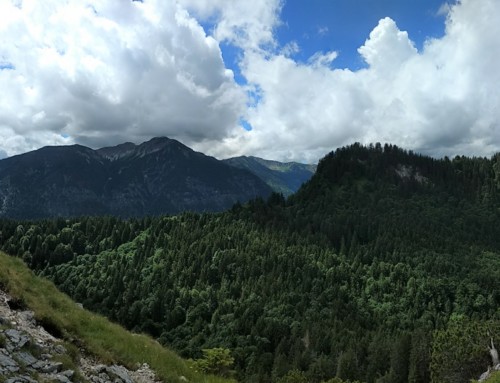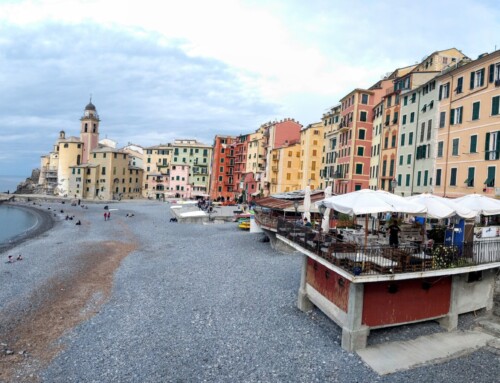“I wish we’d have hiked into San Fruttuoso instead of taking the ferry in both directions. You had mentioned that you often hike in and then take the ferry out. I wish we had done that.” I was having a conversation with one of the couples that joined our Spring 2024 Cultural Debris Excursion to Italy the week after our return. The gentleman was reflecting on the trip after I asked for feedback. This was not the answer I had expected. Two days prior to San Fruttuoso we made a fairly strenuous, but not hard, walk above Genoa. He said that he loved that day in particular because the strain on his knee was offset by the views of the city, the views through the ancient medieval wall above the city and the magnificent multi-course meal served in the family restaurant built into the wall which we enjoyed at the end of that walk. “Perhaps next time,” was my response.
(Abbey of San Fruttuoso as seen from ferry boat)
We did something we had not done before with our excursions this time around. Our guests asked us if we could add a couple of days in Rome at the front end of the Excursion prior to our planned start in Assisi. They asked if we would be willing to curate those days and guide them as an add-on. They’d like to see the city since they were flying in there. Our other guest agreed and jumped in as well. It turned out to be both wonderful for them and illustrative of why we generally stick to the road less traveled. Mrs Ruby says she thinks everyone should see Rome, even if the experience may be different from their expectations. Despite the crowds and lines and group after group after group of 30-100 people following an umbrella-wielding tour guide speaking into a microphone, our guests saw just about all the important sights in 2.5 days plus the Papal audience in which they received the Pope’s blessing from 2 ft away, a private Mass in St Peter’s Basilica, and a private tour of the Angelicum, the Dominican College in Rome. That’s a pretty good add-on.
(Private Mass in St Peter’s)
(Trevi Fountain, Rome)
When we arrived in Assisi, it was like stepping into another world. One might argue that Asissi wouldn’t be Assisi if not for the pilgrims. I’d argue that it is just another example of well-preserved medieval villages that people still live and work in all throughout Italy. Just this one has St Francis, St Claire and the soon to be canonized St Carlo Acutis in the village, not to mention awe-inspiring views and passageways. Finding a little patio cafe and drinking a Spritz with friends is every bit as important as visiting the tombs of saints.
(View of Assisi from Bar San Lorenzo)
Siena is where this past Excursion really felt like the Excursion itself kicked in. Largely because it was our base for 5 days and because one feels like you left something on the table. We like to base out of places where you understand there’s far more you can see than you can experience in a week. Our guests laugh at the end of our time when we bring up articles that tell you the 8 things you need to see in 36 hours. From a private tour of the museum of the Onda Contrada to climbing up into the rafters of the Cathedral, to the delightful day spent in San Gimignano, to the views from the top of Brunelleschi’s Dome in Florence, to the exquisite tasting menus at our Sienese restaurants, to people-watching on the Piazza di Campo, this was a great week for guests and hosts alike.
(Piazza di Campo, Siena)
After 10 days you might think everyone would have been ready to go home. No. It was in Genoa that our guests fairly dropped their jaws. “Now we get it. Now we understand why you want to base out of here each trip.” The combination of the modern and the ancient is so intertwined as to be impossible not to discuss. When you walk into a shop on the ground level of a 6 story building and see Roman arches and the exposed support columns of buildings more than 1500 years old but still in use today one cannot but wonder at what it took to put in the plumbing and electricity, yet keep the ancient building intact.
(Piazza de Ferrari, Genoa)
(Palazzo Rosso, Genoa)
“I haven’t seen any large trash cans anywhere. Only these small little bins. And the tiny fridge doesn’t have a lot in it.” Why do you think that is, we asked our guests. One cannot but imagine what it is to live a life without need for large pantries filled with more packaging materials than the foods they enclose. One cannot imagine life without a large refrigerator with a week’s worth of food, much of which goes stale and thrown away. We can’t imagine life without cars. Yet we delight in walking down the street seeing people select their daily fruits and vegetables from among a dozen local greengrocers every day. We delight in seeing people shop for their daily dinner meat at the local butcher. There are 3 full chain grocery stores tucked into ground floor spaces within 6 blocks of the B&B we stay in. One in our own building. This is what is possible, for which we have to invent excuses for not building.
We saw many tour groups from the docked cruise ship driving or walking past the Basilica of the Annunciation in Genoa where the tourists took pictures of the plain and drab exterior facade. None went into the breathtaking church to see how it was rebuilt to its Renaissance grandeur after being destroyed in WWII. No large groups will go to the mountain village of Ovada and eat a home-cooked meal with Angelo in the farmhouse he is restoring by hand amidst his almond orchard. Large group tours can’t get in the small restaurants where you have a private dining room overlooking the street and dinner served over multiple courses over the evening.
(Basilica of the Annunciation, Genoa)
(Home-cooked meal at Angelo’s farm)
In the book we assign for reading prior to our Excursion, people are surrounded by artifacts from a “time before something happened.” Inquiry and questioning about that time and the meaning of those artifacts is frowned upon and punishable in the book. Today we eagerly travel to places which are filled with artifacts from centuries ago that are still in use today and we seek out why they were created, how they were used, and how we preserve and use them to this day. That is perhaps our greatest joy in Cultural Debris Excursions. Seeing the wonder in our guests eyes and the eagerness to discover that debris from the past and how it is appreciated and loved in the present.
Our October 2024 trip is about to be filled. We will be in Genoa 5-12 Oct and Bologna 12-19 Oct. We have more inquiries from serious guests than we have space. Please write to us as soon as possible if you are interested in spots so that if ones remain open we can get you on the trip. If those two weeks fill, we are seriously considering adding another week in Genoa 19-26 Oct. Cost is $4000 per person per week. That includes excellent lodging, breakfast and the main meal of the day (normally dinner but sometimes a mid-day meal) plus each day’s curated activity.
If you are thinking ahead to next year, our planned Excursions will be to Andalusia, Spain, for two weeks in March, France in May (a week in Toulouse and a week in Annecy), and back to Italy in Oct (Genoa, Bologna and maybe again Siena).
Perhaps our most satisfying comment came on the last night of our May Excursion when one guest said, “I’m never going on another cruise or large group trip again in my life after this experience.” As GK Chesterton put is so well a century ago, “The traveler sees what he sees. The tourist sees what he has come to see.”
Be a traveler, not a tourist.
















Leave A Comment